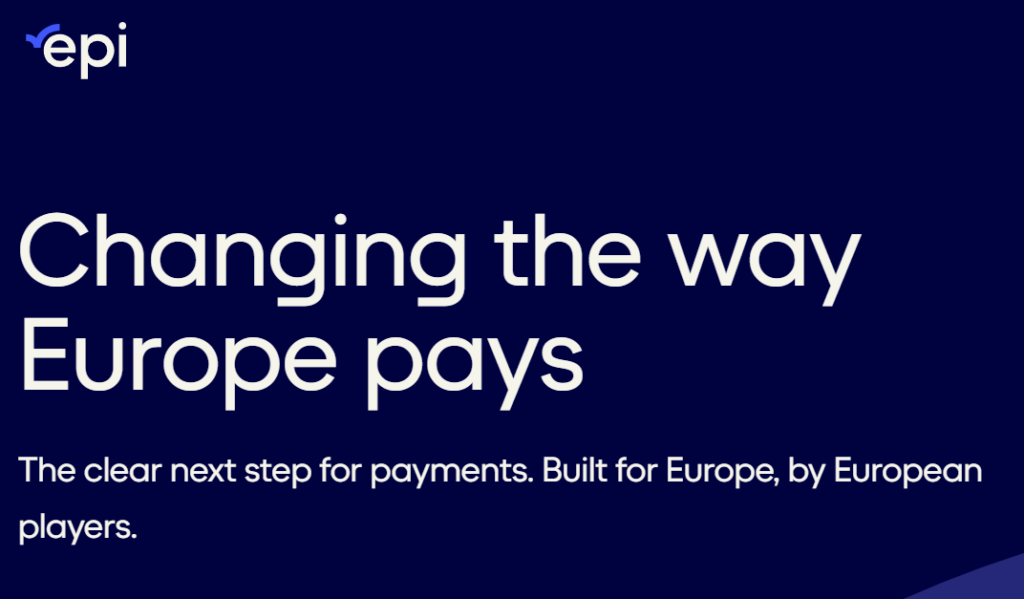Something that should be on the radar for all of us in the European fintech is EPI – European Payments Initiative. It is not something brand new (it saw the daylight about 4 years ago). It is a company and not something that “Europe” has come up with, but it has strong connections to the EU organization and the European Central Bank. It might be a game changer or at least, a part of something game changing.
Background
The background is anxiety. Anxiety in the way that if bad things happen, and Visa, Mastercard and American Express cut its connections to Europe, then Europe should have its own way of doing payments.
With war in Ukraine, unstable Russia, political movement in Europe, Trump-Musk president, China and the fact that the majority of the big payment players comes from either China or USA (Tencent (WeChat Pay), Alibaba (Alipay) vs – Amex, Visa and Mastercard (Paypal)) – bad things can happen.
One example to describe how dependent Europe still is on other countries’ technical solutions is Vipps. The Norwegian initiative from the acquirer Nets and some banks, that later merged with Mobile Pay (Finland & Denmark) and now call themselves a Nordic payment solution. The problem with Vipps is that there is not much innovation behind it because Vipps runs on the rails of Visa – the Visa card scheme is used to do transactions. Merchants also have to pay a percentage-based fee because of the Visa dependency.
There have been attempts to launch solutions like EPI before in Europe. Still without any greater success.

Swish and new EU legislation
Swish is not like Vipps. Swish was sprung out of the technology used by Bankgirot which means it is not dependent on rails from the big international card schemes like Visa or Mastercard. However, it means it only works in Sweden. Great for people in Sweden, but not an initiative that will get applauded from a European perspective.
Why did Swish succeed so well in Sweden? According to me it is because we had the perfect match in time when we stopped using cash and Swish was launched. It is also a very important factor that the phone number instead of bank account number is used as identifier (or a Swish number for merchants).
A more boring fact is that Swish is created and owned by the big banks. It is just lately that more modern banks have been invited.
The big banks sat on almost all the Swedish population’s bank accounts. By removing cash, person to person could not give money to each other any longer and everyone was forced to use digital solutions. Swish was seen as a great invention and the banks made it free for consumers. It was again more or less impossible for any competition to Swish (and maybe competition as not needed either as money transfers should be a human right).
In the contex of Swish being a solution for private persons to transfer money to eachother, this was only the first part of Swish. The second part came a little latter but is where Swish putting all their efforts now. This is that merchants (shops, restaurants etc.) should take payments for their sales with Swish. Swish for merchants is not free. The merchant pays always a fixed fee for each Swish payment. Common is also a percentage fee on top and a recurring monthly fee to have the Swish service activated. Fees are charged via the banks.
If you like conspiracy theories, Swish came to life when EU-legislation made the Swedish “monopoly” for card transactions illegal (before the big banks in Sweden made domestic card transactions cost at a fixed price instead of %-based price).
To add even more to the conspiracy, the merchant’s price for a Swish transaction is close to exactly the same as the former fixed cost for a card transaction. A basic basis of EU’s free trade legislation is that another EU-country cannot block competition from other EU-countries. In December 2015, when the legislation went into force, other acquirers, terminal suppliers, software and gateways could enter the Swedish market. This brought down the prices a lot and made card payments possible everywhere.
Many Swedes for sure remember when merchants asked for an extra 2-3 SEK if you wanted to pay by card. An example with a coffee for 20 SEK could render a fee for the merchant from the acquirer (one of the big Swedish banks) of 2-3 SEK (10 % fee!). The big banks except Swedbank all stepped away and sold their acquiring businesses (Nordea to Nets, SEB to Bambora and later Handelsbanken to Worldline).
The fact that EU set down the foot also started an eventful time for fintech in Sweden. We saw iZettle made card payments possible on many new spots and companies like my own MoreFlo had very fruitful times, even though the competition already from start was tough.
That EU took away the “monopoly” for the big banks in Sweden, made it possible for companies like MoreFlo to use suppliers from all over the world to do card payments in Sweden. In my case we started cooperation with Elavon (US), Miura (China+UK), Payworks (Germany) and CreditCall (UK).
During these times I flew around a lot, trying as a very small Swedish company with no venture capital, to strike deals with big international players.
New possibilities in Europe
On big European markets cash is still a valid part of the payment system. I think this will change of course and then there will be huge possibilities for modern/neo/quick-footed banks. I think where I work, Northmill Bank, there is a lot of potential if we want to take on new markets. (Northmill acquired my company MoreFlo in 2021.)
An important fact to why EPI might mean a change to the way of making payments and money transfers in Europe, is because EPI is backed by the EU and the European Central Bank. That is a big thing, and it lays the ground for the fact that EU really wants a pan-European payment solution.
From a Swedish perspective it is very interesting to know, that if you talk to EPI-people, they know about Swish very well, but they also openly say that they are here to replace Swish. That is not a secret.
I think EPI could make as equally big change for consumers in certain European countries that Swish made for the Swedish people. I explain more bellow.
SEPA – the most important framework for future payments
EPI is based on SEPA which is well covered all over Europe. SEPA is the totally dominant method of money-transfer account to account, probably even the single one to survive when it comes to EURO-countries.
SEPA is used also in Sweden when you want to transfer money abroad. The big banks are well integrated with SEPA and because of another EU legislation they are not allowed to charge any big costs for the transfer. It is called “clearing” – when money is confirmed to have been withdrawn and/or to have arrived from/to a bank account.
Since January 8, 2025 (less than a week ago), all banks within the EU are not allowed to charge any extra cost even if the transaction is instant. Until now they have been able to take an extra charge, often €1, if they were to do an instant SEPA transfer (meaning a SEPA transfer from one bank to another as SEPA within the same bank has always been instant).
I live in France and there is nothing like the Swedish Bankgirot or Plusgirot here. 99 % of all invoices etc. are paid via SEPA. The same goes for many other European countries. Payments are made with IBAN+BIC as a SEPA payment.
It is secure, you do it in your internet bank, you do not need any extra app or so and the transfer is instant.


Scandinavia tried to create its own payment network but failed
On our home markets, Scandinavia, there were initiatives to launch something to compete with SEPA as Norway, Sweden and Denmark do not have any plans to change to euro and there is a lot of trade, travel and work between the Scandinavian countries.
The latest initiative was called P27 and run by the company P27 Nordic Payments Platform AB. It was planned for Sweden, Denmark, Norway and Finland (the number 27 stands for that it lived 27 million people on the market area for P27 (obvious stupid ground for a product name)). Denmark left first and then it didn’t take long before the whole project crashed.
My view is that P27 failed because there are too big differences between the payment systems in the Nordic countries. It is based on too old and unmodern techniques because the big banks has controlled the market for too long and with too little competition.
Unfortunately for us consumers, I also think the big banks make too good profits on the current solutions (as you you now know it is the banks that owns Swish and Vipps). If there were to be launched a common bank-agnostic payment platform, they would have been forced to share the profit.
Another interesting fact about P27 is the board. There are 7 board members plus the CEO. The average age is 63. Every single one of them are born in the 1960’s. This is not exactly the fintech generation. P27 made losses in the last 5 years in around 1 billion SEK (1 000 000 000).
P27 stopped their application to the authorities to have the right to do clearing (to confirm that the money has left and arrived to and from bank accounts). P27 as a legal entity is still there and it acts as a holding company for Bankgirot. P27 is owned by Danske Bank, Handelsbanken, Nordea, SEB och Swedbank (earlier also DNB in Norway and OP Finance Group in Finland where partners/founders).
Now to the exciting parts:
Again, EPI (European Payments Initiative) is based on SEPA. This makes EPI being able to jack-in to already existing technology. This is modern technology, not like Swish which is based in Bankgirot which was founded in 1959 (even I was not born then, it took another 16 years).
To be fair I should say that Swish has started to move to RIX-INST operated by the Swedish central bank, a more modern solution from February 2024. As an example, Northmill Bank’s Swish product is based on the new and modern Swish connection.
Because of EPI using SEPA it also is connected to TIPS – TARGET Instant Payment Settlement. TARGET is not that well known yet, but it is the hot shit in payments today. TARGET is more, but the interesting part is that TARGET make payments in central bank-money. This means country to country. All the (transaction not i.e. investment) banks are then connected to central bank in their country.
TARGET is what makes it possible to do real instant transactions (on Wikipedia they say that 99 % of TARGET transactions using SEPA are settled in 5 seconds).
Is Sweden then left outside?
No, actually not. TARGET has been connected to the Swedish central bank, Riksbanken, since May 23rd, 2022. The real integration to make use of the connection then took some time but was ready and launched in February 2024. So TARGET is connected to Sweden.
In Sweden, Riksbanken has built new solutions and now have two platforms. One for large payments and one for small payments. The one for smaller payments is called RIX-INST. It works 24/7 and transactions take place instantly.
So far there are not many that is connected to RIX-INST but I am sure we will now see a quick increase in banks and others that will make use of RIX-INST. The mentioned new connection that Swish now can offer, is using RIX-INST. But still Swish use themselves as a middleman (“agent”) with the company Getswish AB. This setup is there to generate transaction income for the banks, and that is the reason that the cost for a merchant to do a Swish transaction is very high (about 2-3 SEK + sometimes a percentage-based fee + a monthly fixed fee). Getswish AB is as you probably already have figured out owned by the big banks (so again it is Danske Bank, Handelsbanken, Nordea, SEB, Swedbank plus Länsförsäkringar Bank). Eight other banks are connected and can offer Swish, among them Northmill Bank.
As I wrote earlier, Swish is a domestic payment solution. So far it cannot be used outside Sweden. It is from the beginning built based on Bankgirot and Swish has numerous times been facing stability issues making the platform not working. To overtake other payment methods, the stability of the service cannot be how it is today.

RIX-Inst can be a game changer
RIX-Inst is brand new to everyone in the payment industry and will certainly be a game changer. With TARGET connected to RIX-INST and TARGET connected to EPI, the way is open for anyone to take part in this type of transactions in any European country.
Northmill Bank was the first one to do an instant transaction with RIX-INST. The buzz about this came fast, and I heard from many others in the banking industry that the news where out “Northmill did the first RIX-INST transaction, they are on to something!”.
Swedish banks connected to RIX-INST suddenly can-do instant money transfers at a very low cost. It can be integrated into any type of offering and any type of digital solution (app, internet bank, checkout or digital wallet).
Banks can also let consumers transfer money cross-border in Europe. Just by knowing the phone number of the recipient. This mean real time central bank currency exchange, no middlemen and a lot of saved transaction costs.
Of course the same advantages goes for companies and organizations that wants to either wants to take payments or to transfer money. Imagine to pay with your home currency at a restaurant in a completely different country without any extra currency mark-up. Think of paying online, without being robbed by your credit card adding a 2,5 % extra fee just to make a currency conversion.

WERO
Here in France a top story in the business news now is WERO. It is called a “mobile payment system”. You can compare it with Swish as they use the mobile phone number as the identifier. It was launched in July 2024, and it is EPI that stands behind this product.
In the payment industry many see EPI as the same as WERO. That is true from a marketing and product position point of view, and that’s why it is so interesting for especially the Swedish fintech sector.
France is almost 10 times bigger market than Sweden. Germany, where WERO also is launched, is even bigger. Both these countries are huge markets and where cash soon will be changed for solutions like WERO.
More and more banks gets connected to Wero. An updated list can be found here: https://wero-wallet.eu/about
WERO/EPI is, as I wrote in the beginning, backed by the EU. If you read about it, you can clearly see that the European Central Bank is a stake holder, even though I do not know the details behind this. It is growing like crazy in France, Germany and Belgium and it is probably because the very big banks now are connected. Example of banks connected and promoting WERO; Deutsche Bank, BNP Paribas, Credit Agricole and Socité Generale.
I think it is also a game changer that WERO/EPI now also have Worldline and Nexi connected. They are the two biggest acquirers (card payments) in Europe. We will for sure see online and tap on terminal solutions that works with WERO just like we see with Swish in Sweden.
Because of the closed loop EPI – SEPA creates and acquirer could send transactions here that do not need to use rails from Visa, Mastercard or American Express, making the cost for the transaction be significant lower.
What might talk against both the banks and the acquirer’s kindness is that the now in sole control, Interchange. Interchange is a worldwide solution that gives the issuing bank for a card a big stake of the transaction price when it comes to a card transaction. In the EES-area (“Europe”) interchange is capped to 0,2 % for debit cards and 0,3 % for credit cards. However, 0,2 or 0,3 % on gigantic transaction volumes creates a lot of profit generating income for the banks.
With the already mentioned connections EPI/WERO – SEPA – TARGET – Central Banks, it is now possible to have a European payment method used in both a terminal and online and still without being dependent on Visa or Mastercard.
And, just like that, there is a European alternative to Visa, Mastercard, Amex, Apple Pay Alipay, Tencent pay and all there is from these strange countries over in the east or over in the west. And that was the initial goal behind EPI.

Conclusion
Everyone in the fintech business should make sure they do not miss any chances with this.
- For us in Sweden, Swish will of course not go away, it is a very strong product. But still, when EU start driving initiatives like this it is often so that it becomes a standard.
Daniel Höglund Werngren, 2025-01-12
